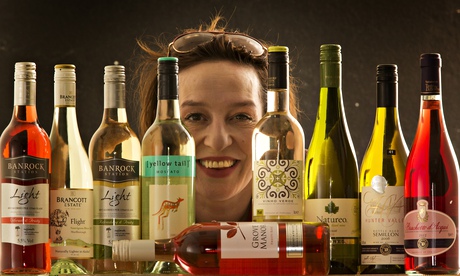
Ah, summer … the carefree season, one seamless tunnel from work to the pub garden. It's like a Barclaycard advert, without the idiotic shopping. The wine is suddenly pink, which means it isn't really wine, it's more of a magical potion. But the days of devil-may-care wine supping, when calories didn't count and alcohol was the whole point, are over. Virtuous wines are ubiquitous. Most supermarkets now calorie-count their wines and New Zealand is trying to lead the world with its low-cal vintners in a $16.97m industry push, a significant part aimed at the British market.
So if we're going to be faced with a load of "healthier" wines, a word on the terminology; it is confusing. There are "light wines", sometimes known as "lifestyle wines", which can mean low calorie ("skinny wines"), low alcohol or both. A bottle will typically only measure one thing, so a low-calorie wine often won't shout about how much alcohol it has. It sometimes won't even tell you what grape it is. A low-alcohol wine will often not acknowledge that calories exist.
In any case, it's meaningless, given the reason wine sabotages diets is not a high calorie-per-millilitre rating, but that it makes you drunk and then you don't care about your stupid diet. So even though technically they aren't, we can consider low-alcohol and low-calorie wines interchangeable.
Within the sub-categories of virtuous wines, there are complicated hierarchies. Some people think low-alcohol is fine, while low-calorie is vulgar. Others think low-alcohol is OK if it's naturally occurring (maybe from a cool climate … mmm … sounds delicious), but actively removing alcohol from wine is crass. I would agree with this, incidentally – having tried Asda's alcohol-removed, 0.5% chardonnay, there are many things I could say about its taste, but the most polite is: "This doesn't taste at all like chardonnay."
Yellow Tail moscato, 7.5%, 114kcal per 142ml, Tesco, £7.57
This was by no means the worst wine, but it was the first, and therefore suffered from the weight of expectation, viz, that it would be just like normal wine, only lighter. It's not. It is extremely sweet and thin, though it did improve the colder it got. How cold would it have to be before you'd choose to drink it? Really cold, but not so cold that it would defy the laws of the natural universe.
1.7/5
Taste the Difference Hunter Valley bottle-aged semillon, 10.2%, 114kcal per 125ml, Sainsbury's, £10
The only wine on the list that a connoisseur would entertain, this isn't tinkered with, but comes from a low-alcohol grape variety. They talk a good game, lauding its "complex toasty aromas" and "lemon citrus flavours". I wasn't impressed, finding it thin and weak. Nevertheless, it at least tastes like reputable wine. I would use it to deglaze a pan, and, if the children were older, as a training wine.
1.5/5
JS Winemakers' Selection Portuguese vinho verde, 9%, Sainsbury's, £4.75
Again, a grape variety that is inherently low in alcohol, and again, I can't find much to love about it: it would taste like a very weak elderflower cordial were it not for the sharp other taste that I charitably called "floral", but was more like "flower vinegar".
1/5
Torres Natureo de-alcoholised muscat, 0.5%, 19kcal per 100ml, Ocado, £5.99
A phenomenal waste of human endeavour – it has no more body than grape juice, yet lacks even the slender charm of that. At the risk of sounding like Samuel Beckett, it tastes only of absence, of what it fails to be. It is strange and sad. I don't say that simply because I wasn't drunk; I took the precaution of being drunk already.
0/5
Taste the Difference brachetto d'acqui, 5%, Sainsbury's, £5
They call it a red but it's more of a deep rosé, not dissimilar to lambrusco, and by dint of that, way too sweet but endearingly nostalgic. I wouldn't be appalled by the idea of putting it on strawberries.
1.5/5
Banrock Station Light chardonnay and sauvignon, 5.5%, 56kcal per 125ml, Ocado, £4.99
This disappears behind your tongue … no, in front of your tongue … it's sort of gone before you've started tasting it, but if that makes it sound mysterious and elusive in a sexy way, get shot of that idea at once.
0.5/5
Brancott Estate Flight sauvignon blanc, 9%, Ocado, £10.49
In the interests of brevity, from now on assume everything is way too sweet unless I expressly say otherwise. The namechecked flavours are passion fruit and grapefruit, but it doesn't taste of fruit; it tastes like the fruit flavour in something else (passion fruit yoghurt?), minus the something else.
0/5
Weight Watchers fruity white wine, 8.5%, 75kcal per 125ml, Morrisons, £4.98
It's never a good sign when, instead of a grape variety, it just says "German". Unbearably bleak, it tastes as though someone has distilled the essence of a downtrodden woman with low self-esteem, then bottled it.
0/5
Banrock Station Light shiraz rosé, 5.5%, 56kcal per 125ml, Morrisons, £4.99
A bubblegummy backtaste and nothing at all going for it; if you want to get drunk on a diet, I suggest vodka and Diet Coke. If you want to be on a diet and stay sober, I can suggest a load of activities, but not one of them is drinking in a pub.
0/5
Grove Manor Fruity rosé, 8%, Aldi, £2.59
"Best served on its own," it says. Best served with a vindaloo. Best served to someone who hasn't got a tongue and drinks through a straw.
0/5

